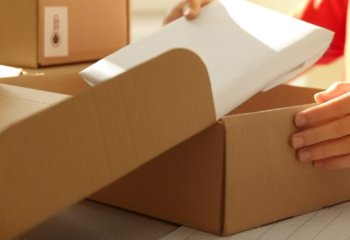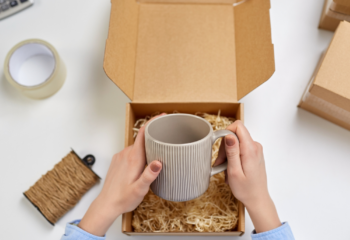Packaging regulations for parcel shipments
Safe and proper packaging of the parcel is essential during transportation.
In order to ensure that your shipment reaches the consignee in a timely manner and undamaged, we ask that you carefully read the packaging regulations for parcel shipments.
Shipments must be with such inner and outer packaging as is necessary to prevent damage to the contents of the shipment:
– during handling of shipment at any angle
– shipment being subject to shocks or falling from a low height (automated sorting lines)
– below the weight of other shipments to the extent of 2-3 times the weight of the shipment itself
If the outer packaging of the shipments is not damaged, while the content is damaged – that means the packaging has been insufficient to withstand the handling cycle. Different goods require different types of packaging depending on the type and nature of goods.
Labels on the packaging such as “Fragile”, “Caution-Brittle” and the directional arrows for handling cannot be taken into account when handling parcels on conveyor lines used for operational sorting of shipments.

ABC of Packaging
Assess
What is the weight of the parcel?
Is the content of the parcel fragile?
Can the content of the parcel leak or spill?

Pack
Use the double cardboard box. Pack it leaving at least 6 cm space between the items and the sides of the parcel. Fill the empty space with the inner packaging to prevent the items from
moving.

Seal and add label
Please use durable packaging tapes. Seal all edges in H-tape pattern. Please attach the label on the top of the parcel. Attach it on ONE surface.

Parcel dimensions
| Service | Maximum standard measurements for the service | Physical maximum measurements with the oversize service |
| Parcel Connect parcel terminal (Estonia, Latvia, Lithuania, Finland) | Weight 25 kg Length 60 cm Width 36 cm Height 60 cm | Weight 31.5 kg Length 60 cm Width 36 cm Height 60 cm |
| Parcel Connect courier parcel (Europe) | Weight 25 kg Length 100 cm Width 60 cm Height 60 cm Max belt measure (1x longest side + 2x width + 2x height) 360 cm | Weight 31.5 kg Length 200 cm Width 60 cm Height 60 cm Max belt measure (1x longest side + 2x width + 2x height) 360 cm |
| Home Parcel (Sweden, Denmark) | Weight 25 kg Length 100 cm Width 60 cm Height 60 cm | Weight 25 kg Length 200 cm Width 60 cm Height 60 cm Max belt measure (1x longest side + 2x width + 2x height) 300 cm |
| PickUp Parcel (Sweden, Denmark) | Weight 20 kg Length 100 cm Width 60 cm Height 60 cm | Weight 20 kg Length 150 cm Width 60 cm Height 60 cm Max belt measure (1x longest side + 2x width + 2x height) 300 cm |
| Express Business Day | Weight 30 kg Length 100 cm Width 80 cm Height 60 cm Max belt measure (1x longest side + 2x width + 2x height) 300 cm | Weight 35 kg Length 200 cm Width 80 cm Height 60 cm Max belt measure (1x longest side + 2x width + 2x height) 300 cm |
Materials and quality requirements
Outer packaging
It is advisable to always use high quality corrugated cardboard boxes. For fragile
or heavy shipments, 2 to 3 cardboard layers are recommended.
Boxes must be impact-resistant with flat (equal) corners.
- Use new, high-quality and durable cardboard boxes. Do not use reusable outer packaging as it may have lost its firmness.
- Film, paper or cloth packaging material shall not be considered as a durable outer packaging.
- The outer packaging must not come loose or disassemble during handling of the package at any angle and when subject to shocks during handling.
- The outer packaging must not deform under the weight of other shipments to the extent of 2- 3 times the weight of the shipment itself. Boxes with insufficient filling may be compressed under the weight of other shipments.
- Overflowing boxes may come loose during handling.


Inner packaging
The inner packaging serves as a shock absorber and protects the contents of the shipment from damage that mayoccur due to parcel shocks during loading processes and on the automated sorting lines. The inner packaging must allow the contents of the shipment to remain fixed during handling. The inner packaging should be used in such a way that it completely fills the free space inside the box.
Materials to use:
Air bags, bubble wrap, shredded paper and cloth, corrugated cardboard, styrofoam, shavings, special fixing foam. Don’t leave empty spaces in the box – 6 cm from all sides of the box. Each item must be packed separately.

Liquids and viscous substances
When packing liquids or viscous substances, please pay special attention to preventing the packages of goods from opening or breaking during
handling. Choose a packaging method that protects the rest of the items inside the parcel in case one of the items leaks or spills. Liquids must be placed in closed containers protected by a rigid cushioning inner packaging. Before placing viscous substances/odorous products in the box, place each individual item it in a film bag, sealing it firmly with adhesive tape. Additionally, please use oil-resistant paper.

BASIC METHOD OF PACKAGING
Suitable for durable goods (printed materials, metal parts, etc.)
Pack it leaving at least 6 cm space between the goods and the sides of the parcel.
Fill all empty spaces inside the box with a cushioning filler (paper, corrugated cardboard, polystyrene foam or paper pellets, bubble wrap, or other fixatives).

ADVANCED SECURITY LEVEL PACKAGING
Suitable for goods with a high risk of damage (cosmetics, glassware, etc.)
Pack each item separately before placing in a box by wrapping it securely with bubble wrap. Please use cardboard separators.
Pack it leaving at least 6 cm space between the goods and the sides of the parcel to be filled in with a cushioning filling (in particular, large bubble wrap, air bags are advisable) in order to ensure complete fixation of the items and amortization during transportation.

HIGHEST SECURITY LEVEL PACKAGING
Suitable for high-value goods with a high risk of damage (hardware, mobile devices, etc.)
Recommended when the original packaging of the product is intended for resale. The first or inner box packaging principle is the same as the previous method.
The outer or second box must be at least 14cm larger than the first box to allow sufficient inner packaging between the two boxes.
For the outer box, it is recommended to use new unused corrugated cardboard box with 2-3 layers.
Sealing the parcels
By carefully sealing the shipment with a durable adhesive tape you will ensure that the package
will not open when handled and that the contents of the package will not be damaged or lost
Choose special adhesive tapes (polypropylene or vinyl) with high adhesion and security level. Do not use adhesive tapes or strings intended for paper, cellophane or stationery as these may tear during
handling.
Use the H-tape sealing method:
- Seal the central joint over the entire length of the package
- Seal both side edges perpendicular to the middle tape
- Repeat the process from both sides of the package
- For heavy shipments, use several layers of adhesive tape


Attaching the label to the parcel
Properly attaching the shipment label or sticker is very important for the parcel to reach its destination
successfully. Incorrectly attached labels may become detached during transportation and the shipment may become unidentifiable (lost).
Attach the label with the address of the consignee on the upper vacant surface of the parcel – do not affix it to adhesive tapes, stitches or fasteners. If there is no such vacant surface, the contents should be placed in a larger box.
The label must not be glued over or covered with adhesive tape. In case you re-use packaging, however, make sure all previously used labels have been removed.
For security reasons, we also recommend that you include the consignor and consignee data inside the
parcel so that the shipment can be identified in the event of loss of the label.